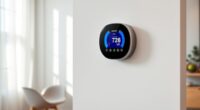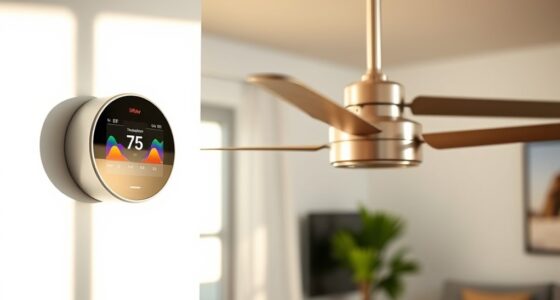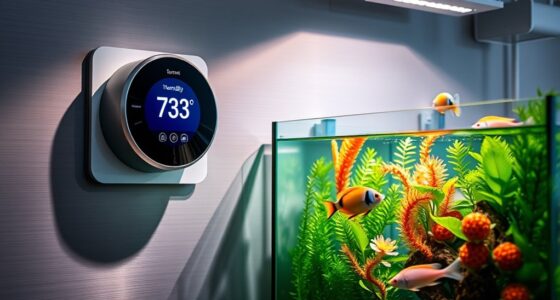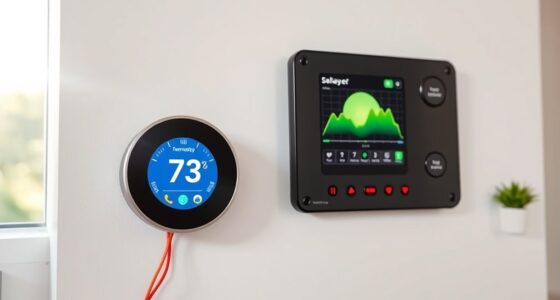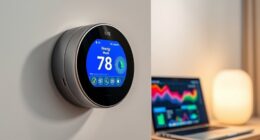Pairing your smart thermostat with smart smoke detectors creates a safer, more efficient home by enabling instant communication during emergencies. When smoke or fire is detected, the detectors can alert your thermostat to shut off HVAC systems, preventing smoke spread and reducing fire risks. This integration also triggers notifications to your phone and automates routines, like turning on alarms or unfasten doors. Explore further to discover how this setup boosts your home safety and energy savings effortlessly.
Key Takeaways
- Ensure compatibility between your smart thermostat and smoke detector via their respective platforms or apps.
- Use the device pairing or setup features within the smart home ecosystem to connect the devices seamlessly.
- Configure automation routines to have the smoke detector alert the thermostat to shut off HVAC systems during emergencies.
- Enable notifications for both devices to receive instant alerts and coordinate safety responses effectively.
- Test the integrated setup regularly to confirm proper communication and emergency response functionality.

Pairing smart thermostats with smart smoke detectors enhances home safety by enabling seamless communication between devices. When these two smart systems work together, you gain a more integrated approach to protecting your home and loved ones. For example, a smoke detector that detects a fire can immediately alert your thermostat to shut off the HVAC system. This prevents smoke from spreading further and reduces the risk of fire escalation. It’s a smart way to improve fire safety, as the quick response minimizes damage and keeps everyone safe. Furthermore, this connection also offers energy efficiency benefits. When a fire is detected or smoke alarms go off, your thermostat can automatically turn off the heating or cooling system, preventing it from fueling the fire or causing unnecessary energy waste. This automation saves you money on energy bills while also adding a layer of safety.
Pairing smart thermostats with smoke detectors boosts safety and energy efficiency through seamless device communication.
You’ll find that pairing these devices is straightforward, especially if they’re compatible with the same smart home platform. Most smart thermostats and smoke detectors come with companion apps that guide you through the pairing process step-by-step. Once connected, you’ll receive notifications directly to your phone if a smoke or fire event occurs, allowing you to respond quickly—even when you’re away from home. These alerts are crucial for fire safety, giving you peace of mind that you’re instantly aware of potential hazards. Plus, many smart smoke detectors can distinguish between different types of alerts, such as smoke or carbon monoxide, ensuring you get the right notifications at the right time. Incorporating smoke detection into your home automation enhances both safety and responsiveness. Additionally, understanding compatibility between devices simplifies setup and ensures reliable operation. The integration also benefits from real-time monitoring, which helps detect issues promptly and prevent emergencies before they escalate.
The integration also allows for custom routines that enhance overall safety and efficiency. For instance, you could set your smart home system so that when smoke is detected, your thermostat not only turns off heating but also triggers smart locks to unlock doors or turn on connected lights to illuminate escape routes. Such features help you and your family react swiftly in emergencies, improving fire safety protocols. On the energy efficiency side, pairing these devices means your home can automatically adjust based on real-time conditions, conserving energy when it’s not needed and ramping up security and safety measures when necessary. This smart coordination reduces waste and promotes a more sustainable household.
In short, pairing your smart thermostat with your smart smoke detector creates a more proactive, efficient, and safe home environment. It streamlines responses to emergencies, minimizes fire risks, and enhances energy savings—all while giving you greater control and peace of mind. As these technologies continue to evolve, you’ll find even more ways to optimize your home’s safety and efficiency through seamless device integration.
Frequently Asked Questions
Can Pairing These Devices Improve Overall Home Safety?
Pairing smart thermostats with smart smoke detectors can definitely improve your overall home safety. This integration enhances user convenience by allowing seamless alerts and responses, such as adjusting temperature settings automatically during emergencies. It also boosts energy efficiency, as your system can optimize heating or cooling based on safety alerts or occupancy. By connecting these devices, you create a smarter, safer home that proactively protects your loved ones while saving energy.
Are There Any Privacy Concerns With Integrated Systems?
While integrated systems bring convenience, they also carry subtle privacy ripples. You should know that manufacturers often use data encryption to safeguard your information, but it’s wise to stay informed about their privacy policies. By understanding how your user privacy is managed, you can make smarter choices. Ultimately, staying vigilant helps ensure your home remains a secure sanctuary, balancing innovation with your peace of mind.
How Do I Troubleshoot Connectivity Issues Between Devices?
When troubleshooting connectivity issues, start by checking your device firmware to confirm everything’s updated. Next, verify your network stability—restart your router if needed. Make sure your smart thermostat and smoke detector are within range of your Wi-Fi signal. Reboot both devices and try reconnecting. If problems persist, reset the devices and re-pair them, ensuring your network remains stable throughout the process.
Do These Smart Devices Require Professional Installation?
You might wonder if these smart devices need professional installation. Typically, installation complexity varies depending on your device’s features and your home setup. Many smart thermostats and smoke detectors are designed for easy, DIY installation, but you should check device compatibility beforehand. If you’re uncomfortable with wiring or setup, hiring a professional can guarantee everything works correctly and safely. Always review the manufacturer’s instructions for the best results.
Are There Compatibility Limitations With Older Smart Home Products?
Is your smart home feeling like an aging castle with crumbling walls? Compatibility limitations with older products often stem from legacy integration issues, where newer devices face device obsolescence. You might find your smart thermostat or smoke detector won’t sync properly if they’re outdated. To keep your smart home seamless, check compatibility before buying new gadgets, ensuring they work together smoothly and don’t become obsolete too quickly.
Conclusion
When you pair your smart thermostat with a smart smoke detector, you’re building a digital safety net that’s as vigilant as a watchful guardian. Together, they create a symphony of safety, responding quickly to threats and keeping your home’s heartbeat steady. Think of it as having a silent sentinel, always on alert, ready to protect your sanctuary. Embrace this tech duet, and turn your home into a fortress of peace and security.

